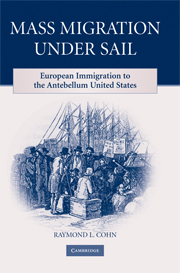Book contents
- Frontmatter
- Contents
- List of Tables and Figures
- Preface
- 1 A Unique Period for Immigration
- 2 The Onset and European Origins of Mass Immigration
- 3 The Jump in Immigrant Volume Around 1830
- 4 Push, Pull, and Other Factors in Antebellum Immigration
- 5 Who Were the Immigrants?
- 6 The Trip from Europe to the United States
- 7 The Immigrants in the United States
- 8 The Effects of Immigration on the United States
- 9 The End of Mass Migration Under Sail
- References
- Index
4 - Push, Pull, and Other Factors in Antebellum Immigration
Published online by Cambridge University Press: 30 June 2009
- Frontmatter
- Contents
- List of Tables and Figures
- Preface
- 1 A Unique Period for Immigration
- 2 The Onset and European Origins of Mass Immigration
- 3 The Jump in Immigrant Volume Around 1830
- 4 Push, Pull, and Other Factors in Antebellum Immigration
- 5 Who Were the Immigrants?
- 6 The Trip from Europe to the United States
- 7 The Immigrants in the United States
- 8 The Effects of Immigration on the United States
- 9 The End of Mass Migration Under Sail
- References
- Index
Summary
The last chapter examined the increasing desire to emigrate from Europe and the declining cost of immigration into the late 1820s as reasons for a jump in the volume of immigration. This chapter completes the story by including an examination of economic conditions in the United States. More generally, however, the chapter investigates whether antebellum immigration can be explained by using the concepts of push factors – events in Europe – and pull factors – events in the United States. In fact, it is argued that few changes in immigrant volume can be explained as being due solely to either push factors or pull factors. One possible exception concerns fluctuations in U.S. economic activity – a pull factor – that has often been found to cause a change in immigration. Sufficient data exist to allow an empirical examination of aspects of this relationship for the antebellum years. Even here, however, the connection is found to be far from exact. Thus, no simple or consistent factors explain the rising volume of immigration and the yearly fluctuations in the flow during the entire antebellum period. Overall, however, the analysis in this chapter results in a more comprehensive explanation for both the sharp increase in immigration around 1830 and the generally rising volume through 1860.
- Type
- Chapter
- Information
- Mass Migration under SailEuropean Immigration to the Antebellum United States, pp. 70 - 97Publisher: Cambridge University PressPrint publication year: 2008



